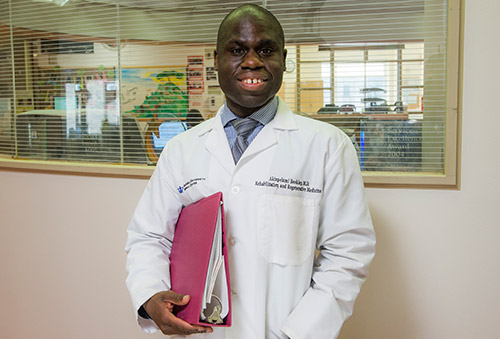About 2 million individuals in the United States are living with the loss of a limb. More than 185,000 amputations are performed each year according to the Amputee Coalition. The recovery journey for people with lower-limb loss is long and complex. The majority of patients undergo amputations due to vascular disease and face the challenge of recovering while also managing with an underlying progressive and chronic systemic condition. People who have lost limbs due to trauma face secondary health issues such as arthritis and low back pain. They also experience increased incidence of age-related chronic conditions linked to reduced physical activity such as obesity, diabetes, peripheral artery disease, and heart and lung disease.
“At NewYork-Presbyterian, our amputation rehabilitation professionals understand that the loss of a limb is more than a surgical procedure; it is an experience that changes a person’s life,” says Akin Beckley, MD, Medical Director of the Inpatient Rehabilitation Unit at NewYork-Presbyterian/Columbia University Irving Medical Center. “For patients with vascular disease, we have a protocol where vascular surgeons and interventional cardiologists refer patients with symptomatic peripheral artery disease to rehabilitation medicine early in their care. I follow them before amputation, as inpatients, and after surgery for follow-up. Particularly important are multispecialty consults with rehabilitation medicine and meeting with patients before surgery to assess their expectations post-surgery.”

Dr. Akin Beckley
Regardless of amputation etiology, these individuals require more energy to walk compared with able-bodied individuals and face challenges in community life due to slower walking speeds and limited physical activity. Despite the best efforts and functional gains during initial training following amputation surgery, limited functional mobility is a reality for most patients with lower-limb loss. Many never reach the independent community walking level even years after amputation. In addition to limited walking ability, falls among people with lower-limb loss living in the community are common, with annual fall rates ranging from 40 to 80 percent, often associated with a lack of confidence in lower balance ability.
Christopher K. Wong, PT, PhD, MS, Professor of Rehabilitation and Regenerative Medicine in the Department of Rehabilitation and Regenerative Medicine at Columbia, in collaboration with Stanford T. Chihuri, an epidemiologist with the Mailman School of Public Health at Columbia, undertook a study to better understand the risk of falls and injuries for amputees.
The authors concluded that by controlling for varying person-steps over time with repeated measures of study participants, the study provides a more precise assessment of all-cause fall and injury risk than previously reported for people with limb loss and adds a novel exposure concept to fall and injury risk analysis.
Specifically, their research examined whether all-cause fall and injury incidence – taking into account daily per person-step exposure over time – varied in people with limb loss with different walking abilities. Ten participants, ages 33 to 63 years old, were enrolled in the prospective study, which assessed individual per person-step exposure repeatedly over four months. Initially, six subjects were categorized as community walkers and four were limited community-household walkers. Their findings, published in the November 2, 2021 issue of Preventive Medicine Reports, demonstrated:
- All-cause fall and injury rates varied significantly depending on community or limited community-household walking ability. The community walking group (n = 6) had six falls and seven injuries; the limited community walking group (n = 4) had four falls and three injuries.
- Both fall and injury risks were higher for those with limited walking ability.
- Fall circumstances varied with most occurring indoors (80 percent).
- Falls were most often due to non-specific reasons, with just two tripping incidents.
- Not all falls caused injury and not all injuries were caused by falls.
The authors concluded that by controlling for varying person-steps over time with repeated-measures of study participants, the study provides a more precise assessment of all-cause fall and injury risk than previously reported for people with limb loss and adds a novel exposure concept to fall and injury risk analysis. They suggest that future studies should investigate the potential impacts of physical therapy beyond initial prosthetic training to include a focus on developing walking ability to help people with limb loss overcome their vulnerability to falls and injury.
Additional research by Dr. Beckley, Dr. Wong, and their colleagues continue to help uncover the difficulties faced by people with limb loss in their day-to-day lives. They help build robust clinical data to support the needs of those impacted by lower levels of physical activity, frequent falls, and compromised quality of life and can inform treatment plans specific to individual clinical circumstances and physical abilities.



